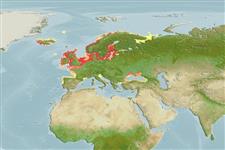Classification / Names
Common names from other countries
Main reference
Size / Weight / Age
Max length : 73.0 cm TL male/unsexed; (Ref. 40637); max. published weight: 10.0 kg (Ref. 35388)
Length at first maturity
Lm 27.1, range 40 - ? cm
Environment
Freshwater; brackish; demersal; pH range: 7.0 - 7.5; dH range: 20 - ?; anadromous (Ref. 51243)
Climate / Range
Temperate; 4°C - 16°C (Ref. 2059), preferred 10°C (Ref. 107945); 73°N - 40°N
Distribution
Europe: Native to Lake Bourget (France) and Geneva (Switzerland, France). Population of Lake Aiguebelette (France) apparently introduced, but a 'lavaret' had already been recorded from there in the 17th century (Ref. 59043). Other authors assume it to be a superspecies occurring in Great Britain and Alpine areas of Central Europe. Has been stocked into many other places in Europe outside its native range. There are many parallel and wrong scientific names for this species in use because of the problems in classifying the genus Coregonus (Ref. 7495). Appendix III of the Bern Convention (protected fauna). Asia: introduced to Iran (Ref. 39702).
Countries | FAO areas | Ecosystems | Occurrences | Introductions
Short description
IUCN Red List Status (Ref. 115185)
Threat to humans
Harmless
Human uses
Fisheries: commercial; aquaculture: commercial; gamefish: yes
Tools
Special reports
Download XML
Internet sources
Estimates of some properties based on models
Phylogenetic diversity index
PD50 = 0.5000 many relatives (e.g. carps) 0.5 - 2.0 few relatives (e.g. lungfishes)
Trophic Level
3.1 ±0.0 se; Based on diet studies.
Resilience
Medium, minimum population doubling time 1.4 - 4.4 years (K=0.3-0.7; tmax=8; Fecundity=3,800 - 169,800)
Vulnerability
Moderate to high vulnerability (51 of 100)
Price category
